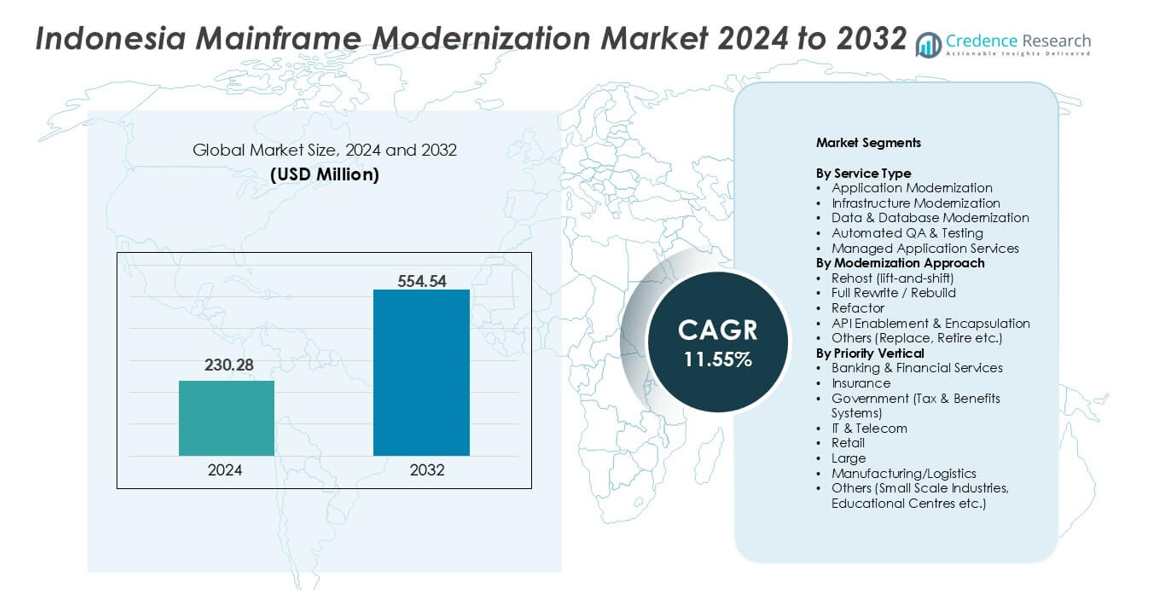CHAPTER 1: INTRODUCTION ………………………………………………………………………………………….. 21
1.1 Report Description ……………………………………………………………………………………………… 21
Purpose of the Report ………………………………………………………………………………………………. 21
USP & Key Offerings …………………………………………………………………………………………………. 21
1.2 Key Benefits for Stakeholders ……………………………………………………………………………….. 22
1.3 Target Audience …………………………………………………………………………………………………… 22
CHAPTER 2: EXECUTIVE SUMMARY …………………………………………………………………………….. 23
CHAPTER 3: INDONESIA MAINFRAME MODERNIZATION MARKET FORCES & INDUSTRY PULSE ………………………………………………………………………………………………….. 25
3.1 Market Overview …………………………………………………………………………………………………. 25
3.2 Hyperscaler & Data Center Investments Unlock Practical Migration Paths ………………….. 28
3.3 Regulation, Data Residency and Government Encouragement …………………………………. 29
3.4 Deep Legacy Complexity, Technical Debt, Lack of Talent and Business-Critical Risk ……… 30
3.5 Lack of Tech Talent for Mainframe Migration in Indonesia ………………………………………. 31
3.6 Skilling, Automation & Managed Application Services ………………………………………………. 32
3.7 API-Driven Integration & Open Ecosystem Enablement ……………………………………………. 33
3.8 Market Equilibrium – Porter’s Five Forces …………………………………………………………….. 34
3.9 Macro Forces – PESTEL Breakdown ……………………………………………………………………… 37
3.10 Market Scenarios (Conservative, Base, Aggressive) – Indonesia ………………………………. 40
3.11 Pricing Trends (Rehost vs. Refactor vs. Rewrite) …………………………………………………. 41
3.12 LOC – Line of Code Assessment ………………………………………………………………………….. 43
3.12.1 Cost Estimation ……………………………………………………………………………………………….. 45
3.12.2 Effort & Timeline Planning ……………………………………………………………………………….. 46
3.12.3 Complexity Assessment ……………………………………………………………………………………. 47
3.12.4 Modernization Approach Selection ……………………………………………………………………. 48
3.12.5 Tooling and Automation Feasibility …………………………………………………………………… 49
3.13 Sector Prioritization – Top 3 Sectors in Indonesia for Mainframe Modernization ……….. 53
3.14 End-Use Client Data ……………………………………………………………………………………………. 54
3.14.1 Banking ………………………………………………………………………………………………………….. 54
3.14.2 Insurance Sector ……………………………………………………………………………………………… 56
3.14.3 Government & Public Sector …………………………………………………………………………….. 58
3.14.4 Healthcare & Pharma Sector …………………………………………………………………………….. 59
3.14.5 Retail & E-Commerce Sector …………………………………………………………………………….. 61
3.14.6 Manufacturing & Automotive Sector …………………………………………………………………. 63
3.14.7 Energy & Utilities Sector ………………………………………………………………………………….. 63
3.14.8 Telecommunications Sector ……………………………………………………………………………… 65
3.15 Key End-User List – Indonesia Mainframe Modernization ……………………………………….. 67
CHAPTER 5: COMPETITION ANALYSIS ………………………………………………………………………….. 68
5.1 Company Market Share Analysis …………………………………………………………………………… 68
5.1.1 Indonesia Mainframe Modernization Market Company Revenue Share, 2024 ……………… 68
5.2 Strategic Developments ………………………………………………………………………………………… 70
5.2.1 Agreements & Acquisitions ………………………………………………………………………………… 70
5.2.2 Expansion …………………………………………………………………………………………………………. 71
5.2.3 New Launches & Partnerships …………………………………………………………………………….. 73
5.3 Competitive Dashboard …………………………………………………………………………………………. 74
5.4 Company Assessment Metrics, 2024 ………………………………………………………………………. 75
CHAPTER 6: INDONESIA MARKET ANALYSIS, INSIGHTS & FORECAST, BY SERVICE TYPE ………. 76
CHAPTER 7: INDONESIA MARKET ANALYSIS, INSIGHTS & FORECAST, BY MODERNIZATION APPROACH …………………………………………………………………………………………… 80
CHAPTER 8: INDONESIA MARKET ANALYSIS, INSIGHTS & FORECAST, BY PRIORITY VERTICAL …. 84
CHAPTER 9: COMPANY PROFILES ………………………………………………………………………………….. 89
9.1 IBM Corporation …………………………………………………………………………………………………. 89
Company Overview …………………………………………………………………………………………………. 89
Service Portfolio …………………………………………………………………………………………………….. 91
Financial Overview …………………………………………………………………………………………………. 92
9.2 Microsoft Corporation ………………………………………………………………………………………….. 93
Company Overview …………………………………………………………………………………………………. 93
Service Portfolio …………………………………………………………………………………………………….. 95
Financial Overview …………………………………………………………………………………………………. 96
9.3 Infosys Limited (PT. Infosys Solusi Terpadu) ……………………………………………………………. 97
Company Overview …………………………………………………………………………………………………. 97
Service Portfolio …………………………………………………………………………………………………….. 99
Financial Overview ………………………………………………………………………………………………… 100
9.4 Accenture ………………………………………………………………………………………………………….. 101
Company Overview ……………………………………………………………………………………………….. 101
Service Portfolio …………………………………………………………………………………………………… 103
Financial Overview ………………………………………………………………………………………………… 104
9.5 Kyndryl ……………………………………………………………………………………………………………….. 105
Company Overview ……………………………………………………………………………………………….. 105
Service Portfolio …………………………………………………………………………………………………… 107
Financial Overview ………………………………………………………………………………………………… 108
9.6 HCL Tech …………………………………………………………………………………………………………… 109
Company Overview ……………………………………………………………………………………………….. 109
Service Portfolio …………………………………………………………………………………………………… 111
Financial Overview ………………………………………………………………………………………………… 112
9.7 Atos SE ………………………………………………………………………………………………………………. 113
Company Overview ……………………………………………………………………………………………….. 113
Service Portfolio …………………………………………………………………………………………………… 115
Financial Overview ………………………………………………………………………………………………… 116
9.8 NTT DATA Inc. …………………………………………………………………………………………………… 117
Company Overview ……………………………………………………………………………………………….. 117
Service Portfolio …………………………………………………………………………………………………… 119
Financial Overview ………………………………………………………………………………………………… 120
9.9 Tata Consultancy Services Limited ………………………………………………………………………… 121
Company Overview ……………………………………………………………………………………………….. 121
Service Portfolio …………………………………………………………………………………………………… 123
Financial Overview ………………………………………………………………………………………………… 124
9.10 Wipro ……………………………………………………………………………………………………………….. 125
Company Overview ……………………………………………………………………………………………….. 125
Service Portfolio …………………………………………………………………………………………………… 127
9.11 Tech Mahindra Limited ………………………………………………………………………………………… 128
Company Overview ……………………………………………………………………………………………….. 128
Service Portfolio …………………………………………………………………………………………………… 130
9.12 DXC Technology Company ………………………………………………………………………………….. 131
Company Overview ……………………………………………………………………………………………….. 131
Service Portfolio …………………………………………………………………………………………………… 133
9.13 Avanade Inc. ………………………………………………………………………………………………………. 134
Company Overview ……………………………………………………………………………………………….. 134
Service Portfolio …………………………………………………………………………………………………… 136
9.14 PT. T Systems Indonesia ………………………………………………………………………………………. 137
Company Overview ……………………………………………………………………………………………….. 137
Service Portfolio …………………………………………………………………………………………………… 139
9.15 PT. Solutech Inovasi Teknologi …………………………………………………………………………….. 140
Company Overview ……………………………………………………………………………………………….. 140
Service Portfolio …………………………………………………………………………………………………… 142
9.16 Crayon …………………………………………………………………………………………………………….. 143
Company Overview ……………………………………………………………………………………………….. 143
Service Portfolio …………………………………………………………………………………………………… 145
9.17 PT Juke Solusi Teknologi ……………………………………………………………………………………. 146
Company Overview ……………………………………………………………………………………………….. 146
Service Portfolio …………………………………………………………………………………………………… 148
9.18 PT Komuri Indonesia (GeekGarden) ……………………………………………………………………… 149
Company Overview ……………………………………………………………………………………………….. 149
Service Portfolio …………………………………………………………………………………………………… 151
9.19 Virtus Technology Indonesia ……………………………………………………………………………….. 152
Company Overview ……………………………………………………………………………………………….. 152
Service Portfolio …………………………………………………………………………………………………… 154
9.20 PT Sigma Cipta Caraka – Telkomsigma …………………………………………………………………. 155
Company Overview ……………………………………………………………………………………………….. 155
Service Portfolio …………………………………………………………………………………………………… 157
List of Figures
Figure 1: Mainframe Modernization Market Revenue Share, By Service Type, 2024 & 2032 ………. 76
Figure 2: Market Attractiveness Analysis, By Service Type …………………………………………………… 77
Figure 3: Incremental Revenue Growth Opportunity by Service Type, 2024–2032 …………………. 78
Figure 4: Market Revenue Share, By Modernization Approach, 2024 & 2032 …………………………. 80
Figure 5: Market Attractiveness Analysis, By Modernization Approach …………………………………. 81
Figure 6: Incremental Revenue Growth Opportunity by Modernization Approach, 2024–2032 …. 82
Figure 7: Market Revenue Share, By Priority Vertical, 2024 & 2032 …………………………………….. 84
Figure 8: Market Attractiveness Analysis, By Priority Vertical ……………………………………………… 85
Figure 9: Incremental Revenue Growth Opportunity by Priority Vertical, 2024–2032 ……………… 86
List of Tables
Table 1: Indonesia Market Revenue, By Service Type, 2018–2024 (USD Million) …………………….. 79
Table 2: Indonesia Market Revenue, By Service Type, 2025–2032 (USD Million) …………………….. 79
Table 3: Indonesia Market Revenue, By Modernization Approach, 2018–2024 (USD Million) …… 83
Table 4: Indonesia Market Revenue, By Modernization Approach, 2025–2032 (USD Million) …… 83
Table 5: Indonesia Market Revenue, By Priority Vertical, 2018–2024 (USD Million) ………………… 87
Table 6: Indonesia Market Revenue, By Priority Vertical, 2025–2032 (USD Million) ………………… 87








